 The
background to this page is taken from a print of 1838 by John Kay
titled 'McArthur, piper to Ranald Macdonald Esq. of Staffa' (the
colouring is assumed to be modern)**. This print is also shown to
the right.
The
background to this page is taken from a print of 1838 by John Kay
titled 'McArthur, piper to Ranald Macdonald Esq. of Staffa' (the
colouring is assumed to be modern)**. This print is also shown to
the right.Contents: Click to go to appropriate section
General / Regimental Variation / Which Side is Which / Heraldic Law - Display / Heraldic Law - Entitlement to Arms / Making and Breaking Heraldic Law / Non-Heraldic Personal Devices / Pipe Banner of the Queen's Own Cameron Highlanders / Links / Bibliography and Sources / Glossary of Heraldic Terms / Pipe Tunes / Contact
Pipe Tunes: You have been greeted by 'The 79th's Farewell to Gibraltar'. It will play once. Further tunes are available at the end of the page
In simple terms, a pipe banner is a heraldic flag
flown from the large bass drone of the bagpipes. They are used by
clan chiefs, chieftains, lairds and military officers of certain
rank. The first written reference to an armorial pipe banner
would appear to be 1679*.  The
background to this page is taken from a print of 1838 by John Kay
titled 'McArthur, piper to Ranald Macdonald Esq. of Staffa' (the
colouring is assumed to be modern)**. This print is also shown to
the right.
The
background to this page is taken from a print of 1838 by John Kay
titled 'McArthur, piper to Ranald Macdonald Esq. of Staffa' (the
colouring is assumed to be modern)**. This print is also shown to
the right.
*Thomas Kirk quoted in 'Early Travellers in Scotland' (Author:Hume-Brown - p285)
**The reverse of the print is inscribed 'Piper to the late Sir Reginald Macdonald Stewart Seton of Touch and Staffa, Bart'.
In the military they are allowed, in general, to officers who command companies of Scottish regiments and those of senior rank. It is held that such officers have a 'following' of soldiers (including the establishment of a company piper) and are thus of the status of a 'laird'; this entitles the company commander to have his banner carried by his piper. A rifle company is normally commanded by a major and generally consists of just over 100 soldiers. For most of the 20th Century there have been three or four rifle companies to an infantry battalion. However, before the First World War there was a different establishment of eight companies, each commanded by a captain, in each battalion. In 1914 these were amalgamated into four 'double-companies' and throughout the Great War (as before it), captains acted as company commanders. As a result some regiments allow 'captain's banners'.
Banners are normally designed to hang down from the drone so that the 'hoist' (a term appropriate to flags and used to describe the edge of a flag nearest the flagpole) is at the top and the 'fly' (the opposite edge to the hoist) below. They are generally made of silk, with fringes of appropriate colours (usually the principal or livery colours of the arms of the owner of the banner). The insignia are finely embroidered with silk or metal thread. Their size is normally 1 foot by 1.5 feet (30 cm by 45 cm). Civic authorities and members of bodies such as the Royal Company of Archers may also have pipe banners.
Military Banners
In a military context, the banner may show the badge of the regiment on one side and a personal device (usually heraldic such as a coat of arms, a crest or the full achievement including supporters if appropriate) on the other side although the practice varies from regiment to regiment. Such banners are normally the personal property of a particular officer although some regiments have banners which are solely regimental property.
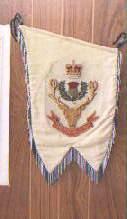
 In some regiments the regimental badge
appears on both sides. the banner of the Queen's Own
Highlanders (Seaforths and Cameron) to the right shows
the regimental badge on both sides with a Seaforth (buff)
facing on the obverse and a blue Cameron facing on the
reverse. The set of banners presented to the Liverpool
Scottish in 1938 at the time of the presentation of
Colours by His Majesty King George VI consists of twelve
pipers' banners and a pipe major's banner which carries
the battle honours as shown on the Colours.
In some regiments the regimental badge
appears on both sides. the banner of the Queen's Own
Highlanders (Seaforths and Cameron) to the right shows
the regimental badge on both sides with a Seaforth (buff)
facing on the obverse and a blue Cameron facing on the
reverse. The set of banners presented to the Liverpool
Scottish in 1938 at the time of the presentation of
Colours by His Majesty King George VI consists of twelve
pipers' banners and a pipe major's banner which carries
the battle honours as shown on the Colours. 
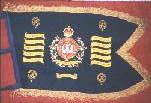 The Liverpool Scottish
set of pipe banners, examples of which is illustrated to
the left , was presented by individuals at the time that
The Liverpool Scottish became part of the Queen's Own
Cameron Highlanders in 1937. The monograms of those who
presented banners are embroidered on a small raised
shield in dark blue silk placed in a corner of the
banner. These distinguishing marks are visible only on
close inspection.
The Liverpool Scottish
set of pipe banners, examples of which is illustrated to
the left , was presented by individuals at the time that
The Liverpool Scottish became part of the Queen's Own
Cameron Highlanders in 1937. The monograms of those who
presented banners are embroidered on a small raised
shield in dark blue silk placed in a corner of the
banner. These distinguishing marks are visible only on
close inspection.
 The banners are similar
in pattern to those of those of the 2nd Battalion Queen's
Own Cameron Highlanders but without the Union flag (see
below). In each corner of the banners is the cypher or
monogram of Queen Victoria (VR - meaning Victoria Regina)
encircled within the garter insignia bearing the motto of
the Order of the Garter 'Honi Soit Qui Mal Y Pense
(meaning 'Evil be to him who thinks evil of it'.
The banners are similar
in pattern to those of those of the 2nd Battalion Queen's
Own Cameron Highlanders but without the Union flag (see
below). In each corner of the banners is the cypher or
monogram of Queen Victoria (VR - meaning Victoria Regina)
encircled within the garter insignia bearing the motto of
the Order of the Garter 'Honi Soit Qui Mal Y Pense
(meaning 'Evil be to him who thinks evil of it'. ![]() A detail of the centre
badge (The Queen's Own Cameron Highlanders with Liverpool
Scottish scroll) may be seen by clicking on the small
image to the right.
A detail of the centre
badge (The Queen's Own Cameron Highlanders with Liverpool
Scottish scroll) may be seen by clicking on the small
image to the right.
These
banners were documented by Colonel R.C. Miers in the 79th
News in 1954: see Bibliography and Sources
The two sides of the banner are known as 'obverse' and 'reverse'
A regiment may specify
In Scotland, heraldry has a recognised place within the law and the Lord Lyon King of Arms is a judicial officer. He has powers to regulate heraldic display in Scotland. Sir Thomas Innes of Learney, as Lord Lyon, laid down prescriptive rules for the form of the banner. In particular, Innes of Learney specified that the personal heraldy should be the surface of the 'shield' spread across the entire surface of the banner in the same way that the arms of the Sovereign occupy all of the Royal 'Standard*'. Even though there may be an 'approved' form for the pipe banner within a regiment laid down in its Standing Orders (which are themselves unlikely to follow Lyon's precepts), there are often exceptions as a banner is made for an officer at his own expense and 'He who pays for the pipe banner calls the thread'. *The Royal Standard is not a true standard in the heraldic sense; one might argue it is a flag or a banner.
Heraldic Law - Entitlement to Arms
The entitlement to arms is a matter fraught with difficulty. Essentially the following should be borne in mind
Making and Breaking Heraldic Law
Sir Thomas Innes of Learney, as Lord Lyon King of Arms, specified that the 'more correct way' to display heraldry on a pipe banner was for the charges of the arms to occupy the whole surface of the personal side of the banner. However, in fact., the forms of heraldic display that might be found are
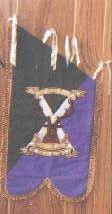
 Shield charges covering the whole
surface of the banner as is shown here on
reverse of the banner of Cameron of Locheil as Honorary
Colonel of the 2nd Battalion, 51st Highland Volunteers.
The arms are Gules (red), three bars or (gold). The
obverse shows the regimental badge of the 51st Highland
Volunteers (which had previously been the Highland
Brigade badge and is now the badge of the 51st Highland
Regiment). The badge is a stag's head affronté on a
saltire (St Andrew's Cross).
Shield charges covering the whole
surface of the banner as is shown here on
reverse of the banner of Cameron of Locheil as Honorary
Colonel of the 2nd Battalion, 51st Highland Volunteers.
The arms are Gules (red), three bars or (gold). The
obverse shows the regimental badge of the 51st Highland
Volunteers (which had previously been the Highland
Brigade badge and is now the badge of the 51st Highland
Regiment). The badge is a stag's head affronté on a
saltire (St Andrew's Cross).

 The complete achievement with shield, helm,
wreath, helm, crest, mantling, compartment and (motto)
together with supporters and slughorn (war cry) if there
is an entitlement. Presumably orders and decorations
might also be added. The example on the right shows the
fish tail banner of Lt. Colonel Arthur A. Gemmell MC who
commanded the Liverpool Scottish 192X - 193Y (later
Sir Arthur Gemmell, sometime President of the Royal
College of Obstetricians and Gynaecologists).
The complete achievement with shield, helm,
wreath, helm, crest, mantling, compartment and (motto)
together with supporters and slughorn (war cry) if there
is an entitlement. Presumably orders and decorations
might also be added. The example on the right shows the
fish tail banner of Lt. Colonel Arthur A. Gemmell MC who
commanded the Liverpool Scottish 192X - 193Y (later
Sir Arthur Gemmell, sometime President of the Royal
College of Obstetricians and Gynaecologists).
 Complete Achievement with Supporters
Complete Achievement with Supporters  The Pipe Banner presented to the 5th/8th
Bn of the King's Regiment to be carried by the pipers of
its Liverpool Scottish company shows the regimental badge
of the King's Regiment on the obverse and the complete
achievement of the City of Liverpool on the reverse. This
banner was carried at the Dedication and Unveiling of the
Liverpool Scottish memorial in Belgium in July 2000 in
the presence of the Lord Mayor of Liverpool. Click on the
smallest picture to see the detail of the King's badge.
The Pipe Banner presented to the 5th/8th
Bn of the King's Regiment to be carried by the pipers of
its Liverpool Scottish company shows the regimental badge
of the King's Regiment on the obverse and the complete
achievement of the City of Liverpool on the reverse. This
banner was carried at the Dedication and Unveiling of the
Liverpool Scottish memorial in Belgium in July 2000 in
the presence of the Lord Mayor of Liverpool. Click on the
smallest picture to see the detail of the King's badge.![]()
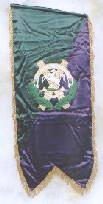
 The design shows simply the shield of
arms of Ieper on the reverse with the regimental badge of
the Liverpool Scottish [the version in use today by the
Liverpool Scottish element of the King's Regiment and
between 1908 and 1937 by the 10th (Scottish) Bn, The
King's (Liverpool Regiment)TF]. The shield of arms may
be seen by clicking here
The design shows simply the shield of
arms of Ieper on the reverse with the regimental badge of
the Liverpool Scottish [the version in use today by the
Liverpool Scottish element of the King's Regiment and
between 1908 and 1937 by the 10th (Scottish) Bn, The
King's (Liverpool Regiment)TF]. The shield of arms may
be seen by clicking here 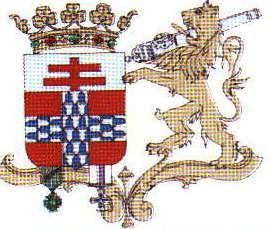 The cross features an heraldic pattern
of blue and white known as 'vair'. Vair is a heraldic
'fur' and its blue and white pattern represents squirrel
fur. In this case, the arrangement is unusual in that the
orientation of the 'bells' is different in the vertical
arm of the main cross when compared with the side arms of
the cross. The historical precedent for this is shown in
the arms displayed on a 1305 for the seal of
nearby town of Bailleul shown on the (now in
France). The full achievement of Ieper is shown to the
right and the French Croix de Guerre and the British
Military Cross awarded to the town after the First World
War may be seen suspended below the shield. The crown
shown should be a mural crown representing ramparts
(Ieper is a walled and moated city) rather than a form of
a ducal crown as shown here. A separate page may be
accessed by clicking here (link active but page
under construction)
The cross features an heraldic pattern
of blue and white known as 'vair'. Vair is a heraldic
'fur' and its blue and white pattern represents squirrel
fur. In this case, the arrangement is unusual in that the
orientation of the 'bells' is different in the vertical
arm of the main cross when compared with the side arms of
the cross. The historical precedent for this is shown in
the arms displayed on a 1305 for the seal of
nearby town of Bailleul shown on the (now in
France). The full achievement of Ieper is shown to the
right and the French Croix de Guerre and the British
Military Cross awarded to the town after the First World
War may be seen suspended below the shield. The crown
shown should be a mural crown representing ramparts
(Ieper is a walled and moated city) rather than a form of
a ducal crown as shown here. A separate page may be
accessed by clicking here (link active but page
under construction)
 The crest with or without the wreath and with or without the
motto and or slughorn (A slughorn is a war cry and in
Scots heraldry is granted only to a chief of a clan or
house). On the right is the banner of Brigadier James
Oliver as Honorary Colonel of 1st Bn 51st Highland
Volunteers. The design of the banner is the Black Watch
pattern (a guidon shape with the regimental badge on one
side and a personal crest on the other). The badge is the
Highland Brigade badge which was adopted by the Highland
Volunteers on their formation in 1967. In 1999, it was
adopted as the badge of the 51st Highland Regiment.
The crest with or without the wreath and with or without the
motto and or slughorn (A slughorn is a war cry and in
Scots heraldry is granted only to a chief of a clan or
house). On the right is the banner of Brigadier James
Oliver as Honorary Colonel of 1st Bn 51st Highland
Volunteers. The design of the banner is the Black Watch
pattern (a guidon shape with the regimental badge on one
side and a personal crest on the other). The badge is the
Highland Brigade badge which was adopted by the Highland
Volunteers on their formation in 1967. In 1999, it was
adopted as the badge of the 51st Highland Regiment.A banner may be made 'personal' by
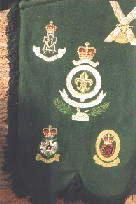
 An example of such a personalisation is
the pipe banner of Lt.Col CTJ Harris who served as OC of
V (The Liverpool Scottish) Company in both the 1st. Bn.
51st Highland Volunteers and 5th/8th (Volunteer) Bn. The
King's Regiment and subsequently as Commanding Officer of
the Liverpool Univertity OTC. The badges on reverse of
his banner represent service with the Liverpool Scottish
in both regiments (Highland Volunteers and the King's)
and his previous volunteer service with the Yorkshire
Volunteers, the Green Howards and the Queen's Lancashire
Regiment. The obverse shows the bonnet badge of the
Liverpool Scottish readopted during Lt Colonel Harris's
period as company commander when the company transferred
from the Highland Volunteers to the King's Regiment. This
is shown to the right. The colours result from artistic
interpretation as the actual bonnet badge is silver.
An example of such a personalisation is
the pipe banner of Lt.Col CTJ Harris who served as OC of
V (The Liverpool Scottish) Company in both the 1st. Bn.
51st Highland Volunteers and 5th/8th (Volunteer) Bn. The
King's Regiment and subsequently as Commanding Officer of
the Liverpool Univertity OTC. The badges on reverse of
his banner represent service with the Liverpool Scottish
in both regiments (Highland Volunteers and the King's)
and his previous volunteer service with the Yorkshire
Volunteers, the Green Howards and the Queen's Lancashire
Regiment. The obverse shows the bonnet badge of the
Liverpool Scottish readopted during Lt Colonel Harris's
period as company commander when the company transferred
from the Highland Volunteers to the King's Regiment. This
is shown to the right. The colours result from artistic
interpretation as the actual bonnet badge is silver.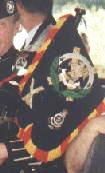 A further example is the banner of Major
GS Green TD, also of the Liverpool Scottish and with
service in both the King's Regiment and the Highland
Volunteers. It shows the Liverpool Scottish bonnet badge
with the Highland Volunteers badge below left and the
King's Regiment badge below right.
A further example is the banner of Major
GS Green TD, also of the Liverpool Scottish and with
service in both the King's Regiment and the Highland
Volunteers. It shows the Liverpool Scottish bonnet badge
with the Highland Volunteers badge below left and the
King's Regiment badge below right. Pipe Banner of the Queen's Own Cameron Highlanders
 Behind
the head of the model (which is wearing the pre-1914 uniform
Uniform of Captain RFB Dickinson) is a blue silk pipe banner.
This would be suspended from the largest drone (the bass drone)
of a set of pipes and carried either on ceremonial occasions or
when pipes are played in the messes. In this case the reverse
side is showing although for this pattern of banner both sides
are identical.The pattern is that of the 79th Cameron
Highlanders, which from 1841 to 1873 used to be in green silk and
thereafter, having become a Royal regiment, the green silk was
replaced with blue. The pattern continued and was used by the 1st
Battalion, The Queen's Own Cameron Highlanders until amalgamation
with the Seaforths in 1961. The centre is embroidered with a
wreath of thistles and the number LXXIX. Officers' personal arms,
crests or monograms were not used on these banners. The 2nd
Battalion of The Queen's Own Cameron Highlanders, raised in 1897,
carried similar blue fish-tailed banners with a central design
similar to that at the centre of a Cameron regimental Colour but
with the Union flag appearing only on one side, the obverse. The
banners of the 2nd Battalion were personal to officers and
carried their crest, monogram or company letter embroidered on
the reverse.The Liverpool Scottish set of pipe banners, an
example of which is illustrated elsewhere, was presented by
individuals at the time that The Liverpool Scottish became part
of the Queen's Own Cameron Highlanders in 1937. They are similar
to the 2nd Battalion pattern but without the Union flag. The
monograms of those who presented banners are embroidered on a
small raised shield in blue silk placed in a corner of the
banner. These distinguishing marks are visible only on close
inspection.
Behind
the head of the model (which is wearing the pre-1914 uniform
Uniform of Captain RFB Dickinson) is a blue silk pipe banner.
This would be suspended from the largest drone (the bass drone)
of a set of pipes and carried either on ceremonial occasions or
when pipes are played in the messes. In this case the reverse
side is showing although for this pattern of banner both sides
are identical.The pattern is that of the 79th Cameron
Highlanders, which from 1841 to 1873 used to be in green silk and
thereafter, having become a Royal regiment, the green silk was
replaced with blue. The pattern continued and was used by the 1st
Battalion, The Queen's Own Cameron Highlanders until amalgamation
with the Seaforths in 1961. The centre is embroidered with a
wreath of thistles and the number LXXIX. Officers' personal arms,
crests or monograms were not used on these banners. The 2nd
Battalion of The Queen's Own Cameron Highlanders, raised in 1897,
carried similar blue fish-tailed banners with a central design
similar to that at the centre of a Cameron regimental Colour but
with the Union flag appearing only on one side, the obverse. The
banners of the 2nd Battalion were personal to officers and
carried their crest, monogram or company letter embroidered on
the reverse.The Liverpool Scottish set of pipe banners, an
example of which is illustrated elsewhere, was presented by
individuals at the time that The Liverpool Scottish became part
of the Queen's Own Cameron Highlanders in 1937. They are similar
to the 2nd Battalion pattern but without the Union flag. The
monograms of those who presented banners are embroidered on a
small raised shield in blue silk placed in a corner of the
banner. These distinguishing marks are visible only on close
inspection.
Click here if you wish to return to the 'Regimental Variation' section of this page
The Liverpool Scottish Regimental Museum Please note: You may have already come to this 'Pipe Banners' page from the Museum site.
The Heraldry Society of Scotland This site (started in Spring 2000) presently carries information on the Society and on where to seek advice on design in connection with Scots heraldry. The journal of the Society is 'The Double Tressure'.
The Heraldry Society The Heraldry Society is based in England but considers all aspects of heraldry. The journal is the quarterly 'Coat of Arms' and there is also the quarterly Heraldry Gazette carrying news items and articles of a more ephemeral nature
Heraldry Today Heraldic booksellers (new, second hand and antiquarian). They publish excellent lists.
The Liverpool Scottish Regimental Association Pipe Band
The Pipe-Banner: C.H. Agnew, Younger of Lochnaw (Sir Crispin Agnew Bt. of Lochnaw). The Coat of Arms (Journal of the Heraldry Society) Vol X No. 75 July 1968. This is a scholarly treatment of the subject. It follows the development of the pipe banner from its first definite recorded appearance in 1679. It also specifies the 'approved' form of the pipe banners for each Scottish regiment of the Regular Army at that time (1968)
Scots Heraldry: Sir Thomas Innes of Learney (revised edition - Malcolm Innes of Edingight pub. 1978 by Johnston and Bacon/Cassell ISBN 0 7179 4224 7). This book, written by the Lord Lyon King of Arms who is the Scots heraldic authority, is generally considered to be the definitive work on Scots Heraldry although some of Innes of Learney's views on the nature of nobility are presently challenged. He is exceptionally prescriptive on the 'correct' form for a pipe banner. In practice, there is wide variation from the form laid down in this book. Malcolm Innes of Edingight, his son and revisor, is the present Lord Lyon (2000)
'Regimental Pipe Banners' (of the Queen's Own Cameron Highlanders): Colonel R.C. Miers (ret'd), 79th News (Journal of the Q.O.C.H) 1954 pp 29-34. This describes all known pipe banners of the Queen's Own Cameron Highlanders and the Liverpool Scottish at the time of writing.
'Pipe Banners': Lt. Col. Angus Fairrie (ret'd), 'The Queen's Own Highlanders (Seaforth and Camerons)', 2nd revised edition 1998 ISBN 0-9508986-2-7, pp 266-267. The section on Pipe Banners details the differing practices of the battalions of the Seaforth Highlanders and the Queen's Own Cameron Highlanders and subsequently that of the amalgamated regiment The Queen's Own Highlanders (Seaforth and Camerons). The practice of the Quen's Own Highlanders has been adopted by The Highlanders following the amalgamation with The Gordon Highlanders.
Glossary of Heraldic Terms To be constructed
A Further Selection of Pipe Tunes
The 'piping' is entirely electronic.
The tunes shown in blue are midi files which are small and quick to download. The sound quality is not high but they give a good impression of the tune. They will play on Windows Media Player or a similar player.
March of the Cameron Men This is not in pipe tune format but comes from the website of The Cameron Highlanders of Ottawa
The Glendaruel Highlanders The regimental march of the Liverpool Scottish
Capt Noel Chavasse VC Written for the unveiling of the Liverpool Scottish memorial plaque in honour of Capatain Chavasse in 1979 by Pipe Sgt Glyn Pritchard of V (The Liverpool Scottish) Company, 1st Bn 51st Highland Volunteers
Evacuation of Cyprus 1974 From the Pipe Tunes of 1st Bn. The Royal Scots, present in Cyprus at the time); a 4 part jig composed by P/M RS Burns which is to be found at page 39 of the Royal Scots Standard Settings (Paterson) - information by courtesy of Major Richard Powell FSA Scot
42nd's Farewell to Major GB Murray Lt Colonel Graham Murray QOHldrs was Commanding Officer of the 1st Bn Highland Volunteers (of which the Liverpool Scottish formed part) at the end of the 1970s. He had previously been 2ic of the 1st Bn The Black Watch (RHR). He was an extraordinary enthusiast for piping and all things Pipes and Drums as well as being himself a piper. It is probable that the Queen's Own Highlanders pipe banner on this page is his. No dawn attack across the North German Plain or the wastes of Otterburn by the Highland Volunteers on exercise was complete without the company piper giving a stirring rendition of a regimental march or charge. He gave the author of this page enormous encouragement when he was a company commander.
Most of the midi files above came from the Midipiper in his huge collection at the 'Bagpipes at Best' site
(Links marked * are not yet not yet active -seeking permission and checking acknowledgement and authorship) Links shown in green are MP3 audio files and are up to 2 Megabytes in size. They take an appreciable time to download but have much superior audio qualities to the midi files. You may need Real Player which may be downloaded (as a free basic version) from the internet here.
Glendaruel Highlanders (2.05 Mb - Slower tempo - The Midipiper)
*Dancing Feet (139 Kb - Pipe Major Chris Eyre Liverpool Scottish Regimental Association Pipe Band)
Captain Noel Chavasse VC (1.89 Mb - The Midipipiper)
*79th Farewell to Gibraltar (312 Kb - Pipe Major Chris Eyre Liverpool Scottish Regimental Association Pipe Band)
*Monymusk (1.29 Mb)
*Scotland the Brave (1.40 Mb)
This site is sponsored by the Liverpool Scottish Regimental Museum
The author, Major Ian Riley TD, may be contacted by e-mail
He does not claim to be an authority on pipe banners but has combined an interest in heraldry with an interest in Scottish Regiments and the Liverpool Scottish in particular. He first noticed pipe banners in August 1969 when at Annual Camp with the Liverpool Scottish and the 51st Highland Volunteers at Thetford in Norfolk. As they hung from the walls iside the ancient Nissen Hut which served as the Officers' Mess, a probable survivor of the Second World War , they transformed otherwise bleak surroundings into a room with the welcoming atmosphere of Scotland.
He would be glad to receive any comments or criticisms in the hope of learning more about pipe banners, their history, their design and current usage